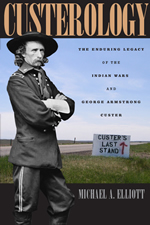A patriotism “too big to fit on a lapel pin”
 Though it might have passed under most peoples’ radar, today, June 25, is the 142nd anniversary of Custer’s Last Stand—one of the most important, and bloodiest, battles of the U.S. conquest of Native American territories. Marking the occasion, Michael A. Elliott, author of Custerology: The Enduring Legacy of the Indian Wars and George Armstrong Custer, has an editorial in today’s Los Angeles Times on the battle and the high levels of patriotic sentiment expressed by many Native Americans today, despite their legendary legacy of resistance. From Elliott’s article:
Though it might have passed under most peoples’ radar, today, June 25, is the 142nd anniversary of Custer’s Last Stand—one of the most important, and bloodiest, battles of the U.S. conquest of Native American territories. Marking the occasion, Michael A. Elliott, author of Custerology: The Enduring Legacy of the Indian Wars and George Armstrong Custer, has an editorial in today’s Los Angeles Times on the battle and the high levels of patriotic sentiment expressed by many Native Americans today, despite their legendary legacy of resistance. From Elliott’s article:
The command of about 600 men Custer led into battle in 1876 included about 35 American Indians, mostly Arikaras but also six Crow and a few Santee Sioux. Some of the Indian scouts would die alongside the 7th Cavalry at Little Bighorn. Others would ride away as the fighting began and spend the rest of their lives recounting what little they saw of the battle. What almost no one knows is that men from the same tribes that fought against Custer would, one year later, be riding alongside the U.S. Army as scouts in the campaign against the Nez Perce—or that the Indian scouts who served the Army in the 19th century became one of the precursors to the Army Special Forces, also known as Green Berets.
This history means that patriotism is rarely simple in the Indian country of the American Plains. American Indian communities have some of the highest rates of enlistment in the U.S. military, yet their leaders also defend the principle of tribal sovereignty—which holds that the tribes should enjoy political and economic autonomy. So at the same time that they are sending men and women to fight on behalf of the United States, many American Indian communities continue to claim their independence from it.
Continue reading at the LA Times website. We have an excerpt from Elliot’s Custerology.
Also, this fall we will publish Norman Maclean’s unfinished work on Custer and the Little Bighorn in The Norman Maclean Reader.